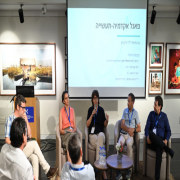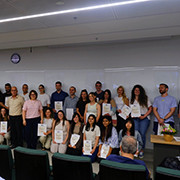Predicting Next Year’s COVID-19 Variants
Using advanced computational methods to identify chronic COVID patients, Tel Aviv University researcher Adi Stern is developing tools for optimizing future COVID vaccines.
More than four years after the COVID-19 epidemic entered our lives and reshaped the world, it has now become a permanent feature among the different viruses humanity has to deal with. Like the flu virus, this means that every year, especially before winter, there is a need for new vaccines to protect the vulnerable populations against the new SARS-CoV-2 strains that emerge. However, this need raises a new challenge: how to identify which strains will be predominant in the months from now so that the updated vaccines will be ready in time?
"This question of identifying future strains is a challenge when planning the flu vaccination campaigns of future seasons. However, with the SARS-CoV-2 virus, this is an even greater challenge because the differences between the strains are much larger than in the flu virus," says Prof. Adi Stern, an expert in the study of evolution and genomics of viruses from the Tel Aviv University Shmunis School of Biomedicine and Cancer Research.
Now, new research by Stern and her colleagues presents a new method for identifying the mutations which are most likely to characterize next season's dominant strains and allow for the preparations of the optimal vaccines against these strains. The paper presenting the method was published in the scientific journal Nature Communications.
At Risk Patients
"Our starting point is people suffering from chronic COVID-19 disease. Chronic COVID is not the same as long-COVID - when the disease symptoms continue even though the virus is already cleared from the body. Chronic patients are people who, because of their weakened immune system, are unable to clear the virus from the body," explains Stern. There are various reasons for such a weakened immune system, such as people who had an organ implant, patients suffering from autoimmune diseases who are treated with medications meant to cripple their immune system, AIDS patients, and - most commonly, patients suffering from hematologic cancers.
"These patients are still at serious risk of suffering from severe disease or dying from COVID. And these patients are also thought to be the source of all the new virus variants. From the ‘point of view’ of SARS-CoV-2, each chronic patient is a huge incubator where it can accumulate mutations until it changes enough to be able to spread in the population."
Stern and her colleagues were one of the first groups to define these chronic patients as patients who retain the virus in their bodies for more than 21 days, in a paper published in 2022. "For that study, we painstakingly located 27 chronically infected patients and sequenced and analyzed the virus mutants they developed. Our latest paper evolved from our efforts to find a more efficient way to identify and study these patients."
Learning the "COVID Language"
To do that, Stern and her colleagues relied on the huge database of 15 million sequenced virus samples and used computational methods to identify samples from potential chronic patients. "The idea is that every such patient will be represented as a clade in the huge phylogenetic tree of the virus sequences. This way we identified 271 potential chronic patients. Next, we taught the computer the ‘COVID language’ - we used large language models (LLMs) to study the sequences, with each mutation as a ‘word’ and a sequence of mutations as a sentence, and after training it on the 271 patients we identified, we asked the LLM to identify more chronic patients, and it located for us 700 more patients."
With this large dataset of virus samples from chronic patients, Stern and her colleagues had enough information to test the hypothesis that they are the source of COVID variants. "With our dataset, we made a list of 14 mutations found in chronic patients in September 2022 that we predicted will become significant in the common variants in September 2023. Out of these 14 mutations, between 7 and 9 indeed became significant, depending on the definition," she says. Another mutation they identified became dominant in the variant that spread around the globe at the beginning of the winter - after the paper was submitted.
"With this proof of concept, our new method could be used to help predict how future variants will look," summarizes Stern. "In combination with other methods developed in different labs, it could help design more effective vaccines."





